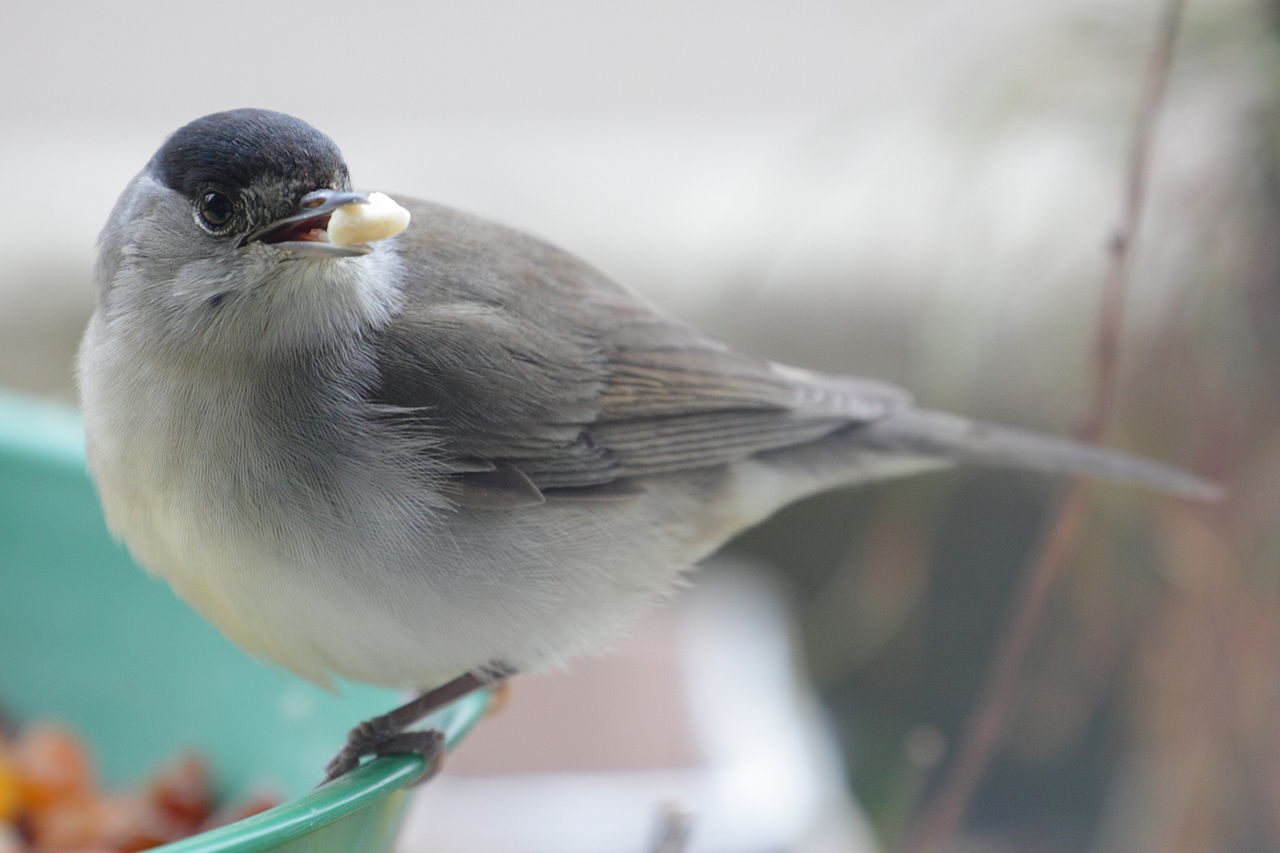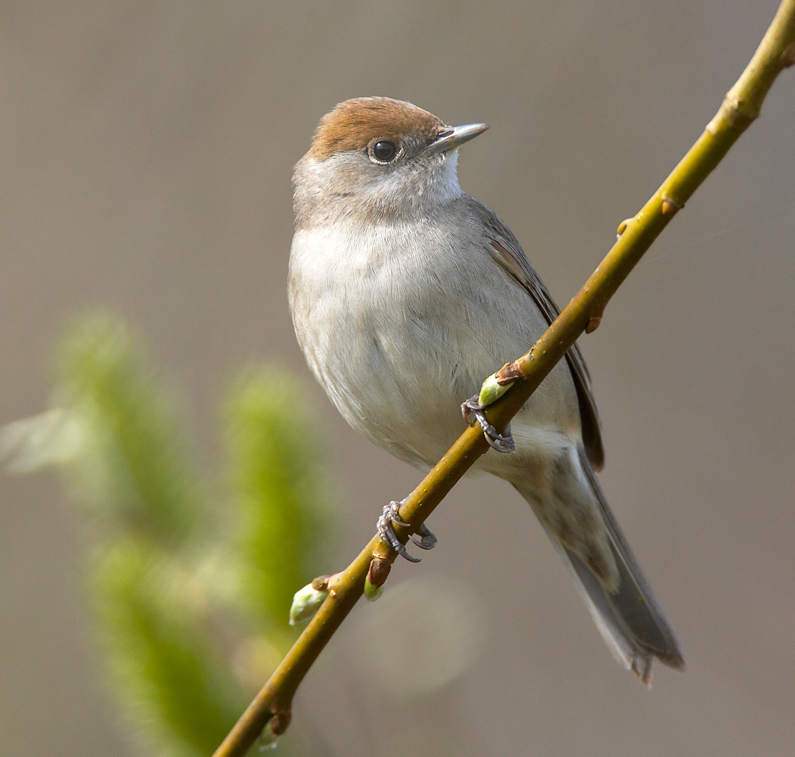Garden Wildlife
Garden Wildlife




Dominique Guillerme, XC697754. Accessible at www.xeno-canto.org/697754.
Dominique Guillerme, XC701402. Accessible at www.xeno-canto.org/701402.
What do they eat?
Blackcaps feed on insects and spiders in the summer, but will take berries, windfall apples, bird-feeder fat balls and sunflower hearts in the winter.
Where do they breed?
In Britain and Ireland breeding blackcaps are summer visitors from the Mediterranean. They nest low down in dense impenetrable vegetation, especially bramble bushes. They breed between April and July, and they generally manage two broods of up to 5 eggs in a year.
What do they do?
Blackcaps were traditionally summer visitors from warmer latitudes, coming here to breed in broadleaf woodland, scrub and suburban gardens, then returning south as winter approaches. These birds are still with us but have been joined in winter by central European birds which used (like our summer visitors) to return to the Mediterranean area for winter. However, a genetically aberrant group “got lost” and ended up in Britain and Ireland for winter, where they have strongly benefitted from our garden feeder stations. Interestingly, they return to claim breeding territories earlier than those birds that headed south for winter, so may be at a competitive advantage, as well as reducing the likelihood of mating with the southern-wintering birds. There is good reason to suppose the blackcap is evolving into two species, driven by our winter food supply in gardens – who says gardens aren’t ecologically important!
How are they doing?
They are doing very well. Our summer visitors have about 1.7 million territories, while winter numbers are in the tens of thousands. Overall the population increased fivefold since 1970. It is ironic that although we now have blackcaps throughout the year, they don’t count as residents!
Finding out more:
BTO profile on blackcap
RSPB profile on blackcap
References on migration and speciation
Plummer KE, Siriwardena GM, Conway GJ, Risely K, Toms MP. (2015) Is supplementary feeding in gardens a driver of evolutionary change in a migratory bird species? Glob. Change Biol. 21, 4353-4363. Abstract here
Delmore, K. E. et al (2020) Individual variability and versatility in an eco-evolutionary model of avian migration. Proc. Roy Soc (B) 287:1938. Paper accessible here.
Page written and compiled by Steve Head
Blackcap Sylvia atricapilla
Blackcaps are primarily a broadleaf woodland and scrub bird. Originally a summer breeding visitor, now seen throughout the year. Recorded in 13% of gardens in Britain and Ireland, but most common in southern and central England.
Male Female
What do they look like?
Blackcaps are small (13cm) birds with dark grey backs and light grey underparts. The male has a striking black crown, coming down to the level of his eyes, while the female has a red-brown crown and has slightly browner underparts.
What do they sound like?
The male’s song is a varied warble and they have a tut-tutting alarm call.
Blackcap Sylvia atricapilla
Blackcaps are primarily a broadleaf woodland and scrub bird. Originally a summer breeding visitor, now seen throughout the year. Recorded in 13% of gardens in Britain and Ireland, but most common in southern and central England.


Male Female
What do they look like?
Blackcaps are small (13cm) birds with dark grey backs and light grey underparts. The male has a striking black crown, coming down to the level of his eyes, while the female has a red-brown crown and has slightly browner underparts.
What do they sound like?
The male’s song is a varied warble and they have a tut-tutting alarm call.
What do they eat?
Blackcaps feed on insects and spiders in the summer, but will take berries, windfall apples, bird-feeder fat balls and sunflower hearts in the winter.
Where do they breed?
In Britain and Ireland breeding blackcaps are summer visitors from the Mediterranean. They nest low down in dense impenetrable vegetation, especially bramble bushes. They breed between April and July, and they generally manage two broods of up to 5 eggs in a year.
What do they do?
Blackcaps were traditionally summer visitors from warmer latitudes, coming here to breed in broadleaf woodland, scrub and suburban gardens, then returning south as winter approaches. These birds are still with us but have been joined in winter by central European birds which used (like our summer visitors) to return to the Mediterranean area for winter. However, a genetically aberrant group “got lost” and ended up in Britain and Ireland for winter, where they have strongly benefitted from our garden feeder stations. Interestingly, they return to claim breeding territories earlier than those birds that headed south for winter, so may be at a competitive advantage, as well as reducing the likelihood of mating with the southern-wintering birds. There is good reason to suppose the blackcap is evolving into two species, driven by our winter food supply in gardens – who says gardens aren’t ecologically important!
How are they doing?
They are doing very well. Our summer visitors have about 1.7 million territories, while winter numbers are in the tens of thousands. Overall the population increased fivefold since 1970. It is ironic that although we now have blackcaps throughout the year, they don’t count as residents!
Finding out more:
References on migration and speciation
Plummer KE, Siriwardena GM, Conway GJ, Risely K, Toms MP. (2015) Is supplementary feeding in gardens a driver of evolutionary change in a migratory bird species? Glob. Change Biol. 21, 4353-4363. Abstract here
Delmore, K. E. et al (2020) Individual variability and versatility in an eco-evolutionary model of avian migration. Proc. Roy Soc (B) 287:1938. Paper accessible here.
Page written and compiled by Steve Head
























